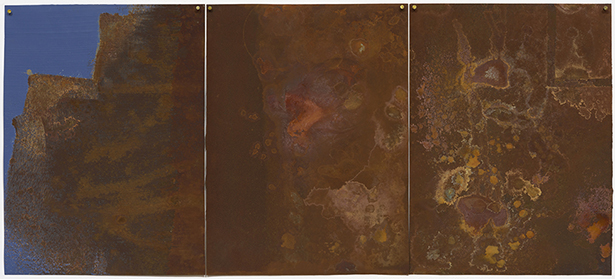June 1–July 17, 2016
Charles H. Scott Gallery
Emily Carr University of Art + Design
1399 Johnston Street,
Vancouver, BC
Canada
The title of Neil Young’s 1979 album Rust Never Sleeps, speaks to the concept behind this exhibition of work by five artists who employ naturally occurring growth—salt, mould, rust, flowers and lichen spores—as their medium. The resulting works address commodity, use value, causality and chance and instability.
Rust is an organic or chemical process of decay. It is also a blight that affects plants. In any form rust is rarely, if ever, a positive thing. We don’t want rust, it damages and destroys. Yet despite our best efforts rust will take hold and grow and once it starts there is very little chance of containing it. Conversely, art is a valuable commodity and its value increases over time. We display it in pride of place to be admired and envied. We ensure it is protected and safeguarded. For these reasons, Ruben Ochoa’s use of rust as a medium in his series of rust on linen paintings is at once unexpected and even blasphemous, yet also richly hued and striking.
Like Ochoa’s rust works, Arnaud Desjardin’s Mouldy Modern confronts the logic of fine art valuation. Desjardin purchased an edition of Histoire Naturelle, a rare 1926 portfolio of prints by Max Ernst. The portfolio that Desjardin purchased however was mottled with a purple mould that was eating away at the surface of the paper. Rather than reducing its value, for Desjardin this added a new layer of meaning to the work, referencing both Ernst’s experimental intentions in originally making the prints and also manifesting traces of time and nature. Desjardin turned the damaged portfolio into a new work that incorporates the mouldy decay and embraces the mutability of the object.
Akin to the repurposing of Desjardin’s Mouldy Modern, Jason de Haan’s Salt Beards grow, both literally and figuratively, from the objects of the past. The affects of time and happenstance of change are played out on their surfaces and symbolic meaning through de Haan’s application of mineral growths that develop and extrude from found and borrowed portrait busts. Like Desjardin, de Haan gives new life, a re-activation to the original object, imagining “a continued growth and change that is potentially physical (biological/geological) and ideological.”
Holly Schmidt explores the ideologies and economics of floriculture in her work Pollen Index. For the exhibition, Schmidt will create a flower shop in the gallery window that will be open during gallery hours and accessible online. The shop will replicate the vendor stalls in the Granville Island Market nearby. Interacting with visitors and passersby, the project will generate discussion about flower cultivation, re-production, the co-evolutionary effects of desire, and the complexity of human relations with the natural world.
Lycopodium, or Witch Powder is a highly combustible moss spore. It was once a homeopathic remedy for a variety of ailments and was also used in explosives (the US government once tested it for potential use in chemical warfare). In the hands of Raphael Hefti, the spores are dusted over photo paper and set alit to make psychedelic multi-coloured photograms. In discussing his approach to making art, Hefti has said, “My direction of the process is intended to create something new away from, or in subversion of, the typical outcome. And of course this new process is prone to its own mistakes, to accidents and not 100% under my control.”
Inviting destabilizing forces into the making of artwork is key to all five of the artists in the exhibition. Though perilous, they nevertheless embrace the risk and unpredictability that comes with using growing matter, with its own predetermined objectives, as a medium.

